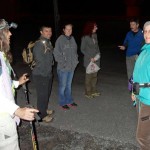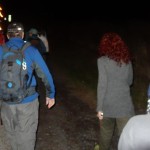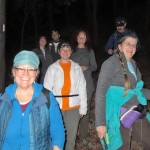 Our moonlight hike was a success even though Mother Nature did not cooperate. We rescheduled for Sunday and had clear skies and a beautiful view of the Moon and the valley below. We also had quite a surprise when two shining eyes observed us very closely from a bush along the trail. Fortunately, it was a deer blinded by our lights and just stood there for us to observe. At least it wasn’t a coyote or bear.
Our moonlight hike was a success even though Mother Nature did not cooperate. We rescheduled for Sunday and had clear skies and a beautiful view of the Moon and the valley below. We also had quite a surprise when two shining eyes observed us very closely from a bush along the trail. Fortunately, it was a deer blinded by our lights and just stood there for us to observe. At least it wasn’t a coyote or bear.

Once at the top of Peter’s Mt. the 8 phases of the Moon and other aspects were discussed: The lunar phases are created by changing angles of the Earth, Moon and Sun as the Moon orbits the Earth. Starting with the New Moon, when the Moon is between the Earth and Sun with the lit side facing away from Earth, the moon is dark and cannot be seen easily. The next phase, the Waxing Crescent, is a sliver of light less than half full. ( Waxing means getting larger with crescent meaning less than half.) The 3rd phase, the 1st quarter or half moon, is just that half full. (Quarter refers to the extent of the Moon’s cycle around the Earth, not its shape.) Waxing Gibbous is the 4th phase with gibbous meaning more than half. The Full Moon phase is the 5th phase, with the Earth between the Sun and Moon, and from that point the Moon begins to wane, decrease in size. From there you have the Waning Gibbous, 6th phase, Third Quarter, 7th phase, and Waning Crescent your last phase. These are the 8 phases of the moon in the Western Culture. Non – Western cultures may use a different number of Moon phases, for example there are a total of 30 different Moon phases in the traditional Hawaiian culture.
The time between two Full Moons is called a Lunar month and is about 29.53 days. This is called the Synodic period or lunation as seen from the Earth. The Sidereal period, or orbital period, is about 27.32 days as seen from outer space, These two periods are different because during the Synodic period we are watching the Moon from a moving platform and during the Moon’s cycle, the Earth has moved approximately one month along its year-long orbit around the Sun. The Earth’s orbital direction lengthens the period for earthbound observers.
We also answered the question, “Does the Moon rotate?” After all we always see the same face in the Moon. The answer being yes, but we always see the same side of the Moon because its counter-clockwise rotation exactly matches the orbit around the Earth so it looks like it does not rotate.
One might speculate that a Lunar or Solar eclipse would occur respectively during the Full Moon and New Moon. This does not occur because the Moon’s orbit is about 5 degrees off from the Earth-Sun orbital plane, Major Lunar eclipses (when the Earth’s shadow blocks the Full Moon) and Solar eclipses ( when the Moon blocks the Sun during a New Moon) are uncommon.
Now that you know so much about the Moon, join our November hike and learn about vultures!




i love to have a photo.